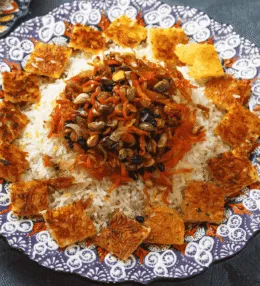
- View
Table of Contents
ToggleLaing is a dish that brings the flavours of the Bicol region of the Philippines to life. It is made from dried taro leaves simmered slowly in coconut milk until the leaves become tender and rich with the creamy sauce.
This is food that knows how to be both earthy and bold. The sauce is often spiked with chilli, creating a balance of heat and creaminess that clings to the leaves and soaks into the rice served alongside.
Laing is hearty without being heavy. It is a dish built on patience, cooked slowly until every leaf softens, soaking up the coconut milk and spices, producing something deeply satisfying with each spoonful.
Want to dive deeper into Filipino Cuisine? Don’t miss our post on 28 Traditional Filipino Foods to Try
What Is Laing
Laing is a coconut milk stew made with taro leaves. The leaves are dried first, then cooked gently with coconut cream, garlic, ginger, onion, and hot chillies. It is a dish that never hurries.
The process of slow cooking is important because it lets the leaves soften and the flavours deepen. By the time it is ready to serve, the sauce is thick, the chillies mellow slightly, and the aroma fills the kitchen.
Laing can be eaten on its own or as a side dish with rice. Some versions include pork or dried seafood, while others keep it vegetarian. The core is always the same: tender leaves and coconut milk combined with spice.
Ingredients and Taste
The main ingredient is taro leaves, which when dried take on a distinct earthy character. Coconut milk forms the base of the dish, providing a rich and creamy background for all the flavours to come together.
Chillies bring heat, ginger adds warmth, and garlic offers depth. Sometimes fermented shrimp paste is added, giving a salty edge. The long cooking time allows these flavours to settle into the coconut cream.
The taste is a mix of soft spice and creaminess. The taro leaves have a gentle, herbal note while the coconut milk softens the heat of the chillies. Each bite has a slow building warmth that feels comforting and full of depth.
A Taste of History
Laing is closely linked to the Bicol region in southern Luzon, a part of the Philippines known for its fondness for coconut milk and chilli peppers. The dish reflects the ingredients grown in the area and the local way of cooking.
The practice of drying taro leaves comes from the need to preserve the harvest. By drying them, families could enjoy the leaves long after the plant season ended, and this tradition shaped the style of the dish.
Over time, Laing became a favourite across the country. Its boldness comes from the Bicolano taste for spice, while its creaminess comes from an abundance of coconuts. It is a dish that feels as much a part of the land as it does the table.
Today, Laing is often cooked for family gatherings and everyday meals. It remains a reminder of how slow cooking and simple ingredients can produce something layered, rich, and memorable with every mouthful.
How to Make Laing (Taro Leaves in Coconut Milk)
Laing is a classic Filipino dish from the Bicol region, where dried taro leaves are slowly simmered in rich coconut milk, aromatics, and chillies until tender and creamy. The dish balances heat with velvety coconut, producing a fragrant and deeply satisfying flavour. See the recipe card at the bottom for printable directions
Ingredients
For the base
- 150 g dried taro leaves (gabi leaves)
- 400 ml thick coconut milk
- 250 ml thin coconut milk
- 200 g pork belly, sliced thinly
- 100 g dried fish or smoked fish (tinapa), flaked
- 4–6 red chillies, whole
- 5 garlic cloves, minced
- 8 shallots, thinly sliced
- 5 cm piece of fresh ginger, sliced
- 2 tbsp shrimp paste (bagoong alamang)
- 1 tsp salt
- 1 tsp ground black pepper
Cooking Instructions
Step 1: Prepare the leaves
To begin, ensure the dried taro leaves are free of grit. Do not wash directly under water to avoid itchiness; instead, wipe gently with a dry cloth. Move to preparing the cooking base.
Step 2: Build the aromatic base
In a wide deep pan, combine thin coconut milk, garlic, shallots, ginger, shrimp paste, pork belly, and flaked fish. Stir well to blend the flavours. Transition to simmering.
Step 3: Simmer the base
Bring the mixture to a gentle simmer over medium heat, allowing the pork to partially cook and the aromatics to release their fragrance. Continue for 10 minutes. Proceed to add taro leaves.
Step 4: Add the taro leaves
Place the taro leaves gently on top of the simmering liquid. Do not stir at this stage to avoid releasing an itchy sap. Let them soften in the steam before mixing. Transition to slow cooking.
Step 5: Slow cook without stirring
Reduce the heat to low. Allow the leaves to slowly absorb the liquid for about 15 minutes. Once they have wilted and settled, you may gently press them into the sauce. Prepare for adding thick coconut milk.
Step 6: Pour in the thick coconut milk
Add the thick coconut milk and whole chillies. Continue to simmer uncovered, letting the sauce reduce and thicken for another 20–30 minutes. Stir occasionally but gently to prevent breaking the leaves. Move to seasoning.
Step 7: Season the laing
Taste the sauce and adjust with salt and pepper to preference. If you prefer more heat, add an extra chopped chilli at this point. Transition to finishing.
Step 8: Cook until oil separates
Continue simmering until the coconut milk reduces and natural oil begins to surface. The leaves should be tender, and the sauce thick and rich. Move to resting.
Final step: Serve
Serve hot with steamed rice. Laing pairs beautifully with grilled meats or fried fish. Presentation tip: Serve in a shallow clay pot for an authentic Bicol style experience.
Variations and substitutions
- Replace pork with prawns for a seafood variation.
- Use fresh taro leaves if available, but dry them first to remove excess moisture.
- Add slices of chilli for a spicier profile.
Cooking Tips for Perfect Laing
- Avoid stirring early in cooking to prevent itchiness from the taro leaves.
- Use thick coconut milk for the final simmer to achieve a creamy, rich sauce.
- Cooking on low heat allows the flavours to deepen without splitting the coconut milk.
- Let the dish rest for 10 minutes before serving to allow flavours to meld.

Filipino Laing (Taro Leaves in Coconut Milk)
Ingredients
For the base
- 150 g dried taro leaves gabi leaves
- 400 ml thick coconut milk
- 250 ml thin coconut milk
- 200 g pork belly sliced thinly
- 100 g dried fish or smoked fish tinapa, flaked
- 4 –6 red chillies whole
- 5 garlic cloves minced
- 8 shallots thinly sliced
- 5 cm piece of fresh ginger sliced
- 2 tbsp shrimp paste bagoong alamang
- 1 tsp salt
- 1 tsp ground black pepper
Instructions
- To begin, ensure the dried taro leaves are free of grit. Do not wash directly under water to avoid itchiness; instead, wipe gently with a dry cloth. Move to preparing the cooking base.
- In a wide deep pan, combine thin coconut milk, garlic, shallots, ginger, shrimp paste, pork belly, and flaked fish. Stir well to blend the flavours. Transition to simmering.
- Bring the mixture to a gentle simmer over medium heat, allowing the pork to partially cook and the aromatics to release their fragrance. Continue for 10 minutes. Proceed to add taro leaves.
- Place the taro leaves gently on top of the simmering liquid. Do not stir at this stage to avoid releasing an itchy sap. Let them soften in the steam before mixing. Transition to slow cooking.
- Reduce the heat to low. Allow the leaves to slowly absorb the liquid for about 15 minutes. Once they have wilted and settled, you may gently press them into the sauce. Prepare for adding thick coconut milk.
- Add the thick coconut milk and whole chillies. Continue to simmer uncovered, letting the sauce reduce and thicken for another 20–30 minutes. Stir occasionally but gently to prevent breaking the leaves. Move to seasoning.
- Taste the sauce and adjust with salt and pepper to preference. If you prefer more heat, add an extra chopped chilli at this point. Transition to finishing.
- Continue simmering until the coconut milk reduces and natural oil begins to surface. The leaves should be tender, and the sauce thick and rich. Move to resting.
- Serve hot with steamed rice. Laing pairs beautifully with grilled meats or fried fish. Presentation tip: Serve in a shallow clay pot for an authentic Bicol style experience.
Nutrition
You May Also Like







Leave a Review